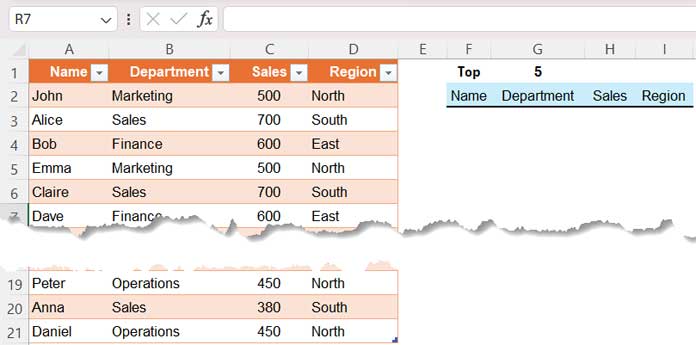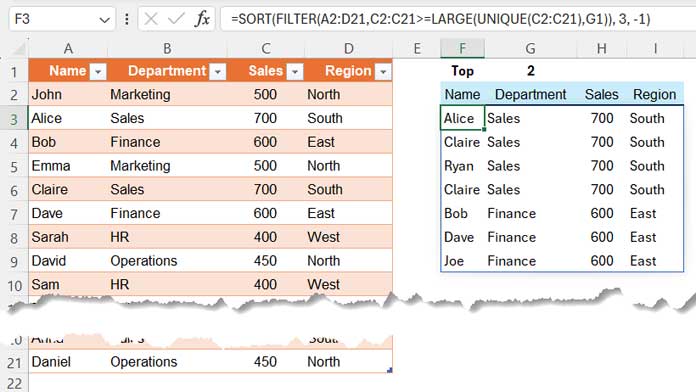When using the FILTER function in Excel to extract the top N values, it’s important to account for duplicates in the amount column.
In this tutorial, you will learn how to obtain top entries using FILTER and other Excel functions.
FILTER is a component of dynamic array functions in Excel, available in Microsoft 365 and Excel 2021.
Sample Data and Filtering Objective
We have a sample sales dataset in an Excel spreadsheet, containing columns for names, departments, sales amounts, and regions spanning cells A1 to D21. The labels Name, Department, Sales, and Region are in cells A1 to D1, respectively.

Our task is to identify the top 3, 5, 10, 20, or ‘n’ sales figures from all regions or a specified region. If we enter ‘5’ in cell G1, a formula in cell F3 should extract the top 5 sales value entries from A1:D21. How can we achieve this in Excel?
Additionally, if the sales amount column contains duplicates, how should we address them?
Determining Maximum Unique Entries in the Amount Column
This step is crucial. While you may have numerous rows of data, if the amount column (the max column) contains only 10 unique entries, specifying ’20’ in cell G1 to filter the top 20 entries will result in a formula failure.
To prevent this, it’s advisable to ascertain the total number of unique values before filtering the top ‘n’ values.
Enter the following formula in any blank cell:
=COUNT(UNIQUE(C2:C21))If it returns ‘8’, you can enter any number between 1 and 8 in cell G1.
The above formula provides the maximum number of unique records concerning sales that can be filtered from the range A1:D21.
Using the FILTER Function to Extract Top N Values in Excel
Let me provide you with the generic formula, so you can easily adapt it to your data. Then we will apply the same to our sample dataset.
Generic Formula:
=SORT(FILTER(range, amount_column>=LARGE(UNIQUE(amount_column), n)), amount_column_index, -1)So the formula in cell F3 for our sample dataset will be:
=SORT(FILTER(A2:D21, C2:C21>=LARGE(UNIQUE(C2:C21), G1)), 3, -1)In this formula, the value in cell G1 is 5. If you enter 3 in cell G1, the formula will return the top 3 values.
Formula Breakdown:
FILTER(A2:D21, C2:C21>=LARGE(UNIQUE(C2:C21), G1)) – filters the range A2:D21 based on the condition C2:C21>=LARGE(UNIQUE(C2:C21), G1).
In the condition, the UNIQUE function returns the unique amounts in column C (C2:C21), and the LARGE function returns the nth largest value from these unique amounts.
The FILTER function filters the range if the value in the amount column (C2:C21) is greater than or equal to the nth largest value in the amount column.
The SORT function sorts the filtered range in descending order based on the amount column to arrange the largest amounts at the top.
Does the Formula Account for Duplicate Amounts?
Yes, it does! If the sales amounts are {20, 20, 5, 5, 1, 1}, the top 2 will include {20, 20, 5, 5}, not just {20, 20}.
Please refer to this screenshot for clarification.

How to Obtain Top N Values Based on a Condition in Excel
Suppose you want to retrieve the top ‘n’ sales values from the North region. You can achieve this by incorporating an additional condition within the FILTER function, i.e., (D2:D21="North"), and applying a filtered range within the UNIQUE function.
Generic Formula:
=SORT(FILTER(range, (criteria_column="criteria")*(amount_column>=LARGE(UNIQUE(FILTER(amount_column, criteria_coulmn="criteria")), n))), amount_column_index, -1)Formula:
=SORT(FILTER(A2:D21, (D2:D21="North")*(C2:C21>=LARGE(UNIQUE(FILTER(C2:C21, D2:D21="North")), G1))), 3, -1)Where:
A2:D21: Range to filter(D2:D21="North"): Filter condition 1(C2:C21>=LARGE(UNIQUE(FILTER(C2:C21, D2:D21="North")), G1)): Filter condition 2
The asterisk is an alternative to AND, signifying that both conditions must be TRUE.





















